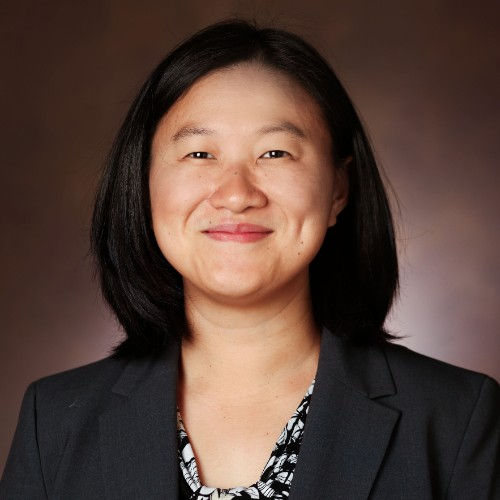2025 Golden Stethoscope Award: Dr. Lucy He, Providence Alaska Medical Center
- jann063
- Aug 22, 2025
- 4 min read

AHHA is honored to present the 2025 Golden Stethoscope Award to Dr. Lucy He, M.D. at Providence Alaska Medical Center. This award is one of AHHA's annual Healthcare Champion Awards given to recognize individuals and teams taking progressive and effective steps to improve patient care and outcomes. Each year, awardees are selected from nominations submitted by member facilities across Alaska; we present the awards at our annual conference in September at a special awards luncheon.
Dr. He, a neurosurgeon and partner with Anchorage Neurosurgical Associates, has been instrumental in changing Alaska’s stroke care landscape. Thanks to her vision, passion and ability to build collaboration among stakeholders, new statewide systems, technology and educational resources are saving lives and improving quality of life for Alaska stroke survivors.
Stroke is the fifth leading cause of death and the leading cause of disability in Alaska. It occurs when a blood clot or ruptured vessel blocks blood flow to the brain. Most strokes are clot-based (ischemic) and require treatment within 4.5 hours of symptom onset to prevent severe brain damage or death.
Every minute during a stroke, the brain loses about two million neurons—equivalent to 3.5 years of aging per hour. Rapid access to emergency medical care, especially surgical intervention, is paramount to survival and minimizing permanent brain damage and disabilities.
When Dr. He arrived in Anchorage in 2018, she quickly recognized there was no standard system for stroke care and collaboration among Alaska hospitals. For each stroke patient, time-consuming image transfers and multiple consultations were conducted between different facilities. If surgery was ultimately needed, patients were often transferred to Anchorage or Seattle because local hospitals didn’t have the surgical expertise to help them. This lack of coordination and local expertise could create devastating delays that were often compounded by Alaska’s isolated geography and extreme weather.
A natural-born problem solver and big-picture thinker, Dr. He was determined to find ways to overcome these obstacles.
She began by joining forces with Robert Lada, M.D., and the stroke coordinators at Providence Alaska Medical Center, Mat-Su Regional Medical Center, and Alaska Regional Hospital to formally establish the Alaska Stroke Coalition in 2023. This non-profit group unites hospitals, clinicians, healthcare workers, families, administrators and emergency services across Alaska to address three pillars of stroke care – prevention and education, acute stroke care and recovery.
Through participation in the American Heart Association’s Get with the Guidelines Rural Health Care Outcomes Accelerator project, Dr. He and the Coalition developed new statewide protocols on the transport and care of stroke patients and enabled Alaska hospitals to share important stroke data. Thanks to private grant funding secured by Dr. He on behalf of the Alaska Stroke Coalition, all Alaska hospitals can participate in the Premier data repository for free through December 2027. Participation elevates each facility’s processes and outcome metrics and collectively allows the State of Alaska to benchmark performance against national best practice metrics.
To facilitate the new statewide protocols, the grant funds also allowed the Coalition to help six Alaska hospitals secure RapidAI stroke imaging technology via the RAPIDAK Project. This advanced computed tomography (CT) imaging software shortens stroke assessment and response times using artificial intelligence to read imaging results and identify issues within minutes. Cloud-based imaging technology has reduced image transfer time by 90% (from 45 to five minutes) and connects care teams at different institutions to work in parallel rather than consecutively.
In conjunction with the installation of RapidAI, the Coalition also worked with these hospitals to
enhance their CT systems with advanced image processing software for perfusion imaging –
the gold standard for evaluating whether a patient is a candidate for surgical intervention.
Today, 11 Alaska hospitals in nine communities (Anchorage, Kodiak, Utqiagvik, Bethel, Juneau,
Fairbanks, Soldotna, Homer and Wasilla) use RapidAI to cooperatively expedite emergency
care for stroke patients.
To complement these initiatives, Dr. He has also championed the expansion of advanced stroke treatment capabilities in Alaska. Thanks to her persuasive persistence, both Providence Alaska Medical Center and Alaska Regional Hospital now have specialized biplane imaging surgical suites and both are certified as Comprehensive Stroke Centers by DNV in collaboration with the American Heart Association and the American Stroke Association.
To further bolster the continuum of care, Dr. Le's advocacy led to the expansion of the Providence Telestroke team of neurologists from just three to 47 providers and the establishment of specialized neurocognitive rehabilitation services at Providence St. Elias Specialty Hospital.
The changes led by Dr. He have significantly impacted stroke treatment for Alaskans. In 2024, 115 patients with acute ischemic stroke were able to receive lifesaving treatment in Alaska and only 10 required transfers to Seattle (compared to 86 patients in 2023, and 55 patients in 2022.) It’s expected that more than 150 patients will be able to receive in-state stroke treatment in 2025.
In the meantime, Dr. He is working tirelessly with state lawmakers to pass legislation that amends existing laws to enhance the framework for handling major emergencies, including strokes.
Dr. He is certified by the American Board of Neurological Surgery and is a member of the
American Association of Neurological Surgeons (AANS), Congress of Neurological Surgeons
(CNS), and Alaska State Medical Association (ASMA). A graduate of Case Western Reserve
University School of Medicine (Cleveland, Ohio), she completed residency training at Vanderbilt
University Medical Center (Nashville, Tennessee) and endovascular and operative vascular
fellowship training at Beth Israel Deaconess Medical Center (Boston, Massachusetts) and
Vanderbilt University Medical Center.



Comments